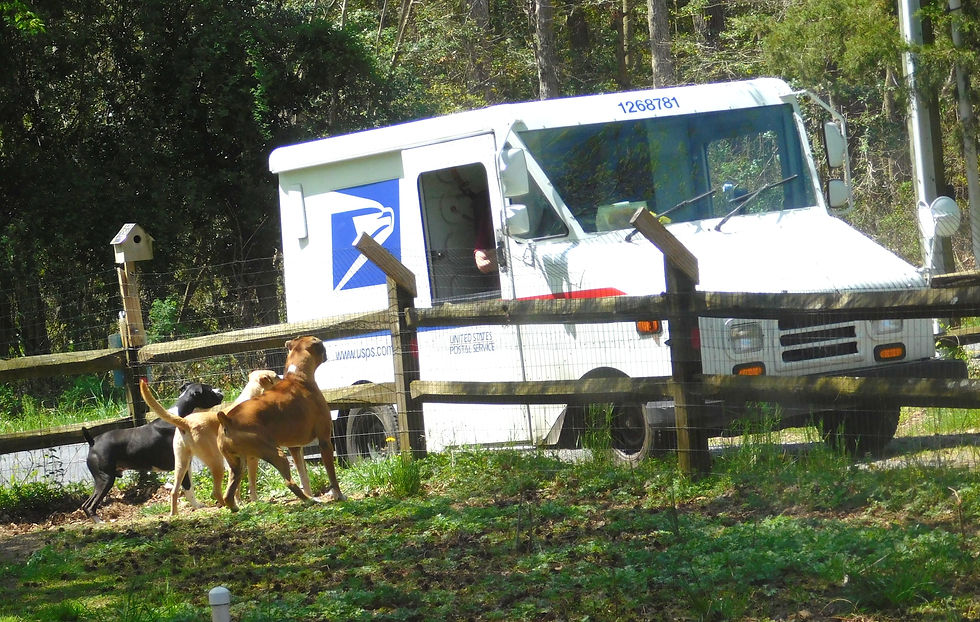"Walter and the Vultures"
- Steve Childers

- Apr 22, 2022
- 4 min read
We live in rural Kent County, Delaware, near the town of Woodside, and we have an 11-month-old "puppy" named Walter. Like any good watchdog, Walter constantly stands vigil in our fenced-in front yard, watching for suspicious joggers, bikers or any white cars or trucks resembling the USPS vehicle. (Our postwoman gives biscuits to the dogs on her route)


The latest "suspicious characters" on his list are vultures. I'm not sure which species of vultures they are. They could be Turkey Vultures (Cathartes aura) but, more likely, they are Black Vultures (Coragyps atratus), because I haven't noticed that they have red faces. As you have probably already seen for yourself, vultures are always soaring about, looking for the unfortunate victims of mayhem.

A month or so ago, very near our house, an opossum (Didelphis virginiana) failed to make it across the road and two vultures had taken notice of the dead body lying on the shoulder. And Walter had taken notice of the vultures. By the way, Walter's nick-name is "Sir Barksalot."
Bark, bark, bark! Bark, bark, bark!

Bark, bark, bark, all morning long! So finally I took a shovel and an empty dog food bag (we have lots of them,) and I transferred Mr. Opossum from the road-side to a place about a hundred yards into the field on the other side of our house. And I placed him carefully so that Walter couldn't see any of the goings on, but we could. As I walked back to the house I looked up and I noticed that the two vultures had followed me and were already circling that spot in the field. Within a few days the vultures had done what vultures do and there was no more sign of the dead 'possum.
Jump forward to a few days ago... Bark, bark, bark! Bark, bark, bark! Bark, bark, bark, all morning long! So I look carefully to make sure the Russians aren't coming down the road, or some other invasion, and sure enough, there's another dead 'possum and another vulture (I guess it was another one, they all look pretty much the same to me.) and all the while, bark, bark, bark! Bark, bark, bark! Bark, bark, bark. So, I got the shovel and another empty dog food bag (with three good sized dogs, we really do have lots of them,) and I made another gruesome, dead body transfer to about the same spot in the field.
Then, the next morning I'm sitting in the sunroom, doing the Sunday crossword puzzle, and when I glanced out into the wheat field where I had put the dead 'possum, I saw a white head bobbing up out in the foot-tall wheat. A Bald Eagle had chased the vultures off and had taken possession of the carcass! I got my camera, with the telephoto lens, and I snuck outside and peeked around the corner of my shop. But eagles have extremely good eye-sight and he quickly took off. Dang!
(I took the pictures below in the same field, but on another occasion.)

Later in the day we were walking the dogs, as we do twice a day, every day. and suddenly the eagle swooped down out of a tree, talons barred, snatched up the dead animal, and flew off across the field. However, it was a large 'possum and the eagle never got more than two or three feet high. After a couple of hundred yards he gave up, dropped it and flew away. If he came back later to reclaim his stolen booty, I didn't see him.

I refer to the Bald Eagle (Haliaeetus leucocephalus) as "him", but it could just as well have been a female. It would be difficult to tell the difference.
The Black Vulture (Coragyps atratus) is one of the most widely seen of American birds, with a range in the United States that includes the entire East coast as far north as New Hampshire, and from there in a somewhat diagonal line through the center of Texas. Their range also includes most of Mexico, and all of Central and South America, except for the far southern tip of Chile and Argentina.

It should come as no surprise that they feed almost exclusively on carrion, sharing a carcass with relatives, and feeding their young for months after they have learned to fly. Black Vultures usually nest on the ground in hidden brush piles or thickets. In the spring of 1999, the first year after we moved to the Woodside area, we noticed a pair nesting in a greenbrier patch in the woods, not far behind our house. I never did see the young, but my wife said they resembled fuzzy, blond-colored young chickens with black faces.

If you see a group of vultures roosting in trees, know that you are looking at a family group, as they tend to aggressively defend their chosen roosts from non-relatives. (Apparently, vultures can tell one vulture from another) On cool mornings they can be seen with their huge wings spread wide to soak up heat from the sun.

You may think of them, and the similar looking Turkey Vulture (Cathartes aura), as gross, disgusting birds, but try to imagine what it would be like without them. They do a great job cleaning up the bodies of dead animals, no matter how the animals may have met their fate. But a word of warning: If you see them in the road and you drive up on them too quickly, they will very likely empty their stomachs and/or their bowels as they try to fly out of your way! Their strong stomach acid is said to eat the paint right off of your car.

Eagle pictures by myself, vulture pictures by Paul Layton.


Great Story! Say Hello to Walter for us.
Jim Deitz, from Afar...